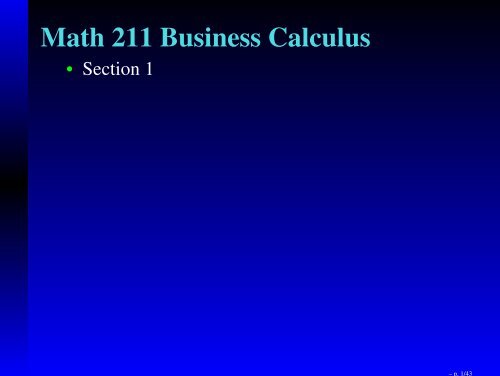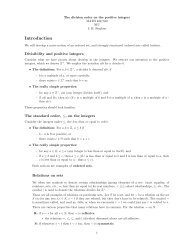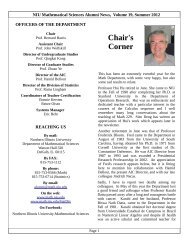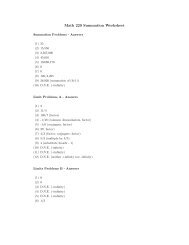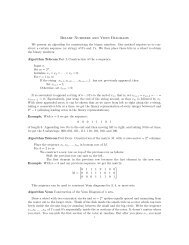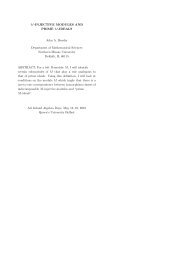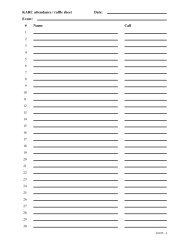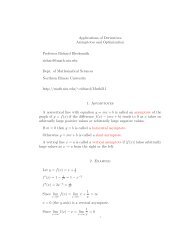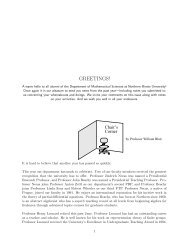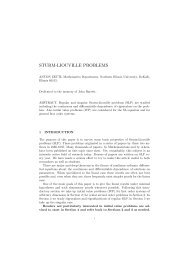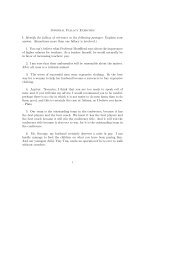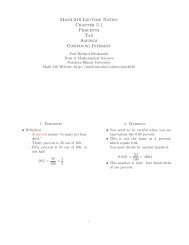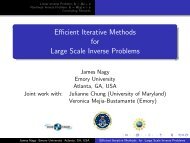Math 211 Business Calculus - Department of Mathematical Sciences ...
Math 211 Business Calculus - Department of Mathematical Sciences ...
Math 211 Business Calculus - Department of Mathematical Sciences ...
You also want an ePaper? Increase the reach of your titles
YUMPU automatically turns print PDFs into web optimized ePapers that Google loves.
– p. 1/43<strong>Math</strong> <strong>211</strong> <strong>Business</strong> <strong>Calculus</strong>• Section 1• Summer, 2012• Mon, Tues, Wed, Thurs• 8:00 - 9:15 a.m.
– p. 1/43<strong>Math</strong> <strong>211</strong> <strong>Business</strong> <strong>Calculus</strong>• Section 1• Summer, 2012• Mon, Tues, Wed, Thurs• 8:00 - 9:15 a.m.• Reavis Hall 201
– p. 1/43<strong>Math</strong> <strong>211</strong> <strong>Business</strong> <strong>Calculus</strong>• Section 1• Summer, 2012• Mon, Tues, Wed, Thurs• 8:00 - 9:15 a.m.• Reavis Hall 201• Independence Day Holiday is Wednesday, July 4
– p. 1/43<strong>Math</strong> <strong>211</strong> <strong>Business</strong> <strong>Calculus</strong>• Section 1• Summer, 2012• Mon, Tues, Wed, Thurs• 8:00 - 9:15 a.m.• Reavis Hall 201• Independence Day Holiday is Wednesday, July 4• Pr<strong>of</strong>essor Richard Blecksmith• Dept. <strong>of</strong> <strong>Math</strong>ematical <strong>Sciences</strong>• Northern Illinois University
– p. 2/43Instructor InfoPr<strong>of</strong>essor Richard Blecksmith• Office: 355 Watson Hall• email: richard@math.niu.edu
– p. 2/43Instructor InfoPr<strong>of</strong>essor Richard Blecksmith• Office: 355 Watson Hall• email: richard@math.niu.edu• phone: 815-753-6753
– p. 2/43Instructor InfoPr<strong>of</strong>essor Richard Blecksmith• Office: 355 Watson Hall• email: richard@math.niu.edu• phone: 815-753-6753• hours: Tues 9:30 - 10:30
– p. 2/43Instructor InfoPr<strong>of</strong>essor Richard Blecksmith• Office: 355 Watson Hall• email: richard@math.niu.edu• phone: 815-753-6753• hours: Tues 9:30 - 10:30• Wed 9:30 - 11:00
– p. 2/43Instructor InfoPr<strong>of</strong>essor Richard Blecksmith• Office: 355 Watson Hall• email: richard@math.niu.edu• phone: 815-753-6753• hours: Tues 9:30 - 10:30• Wed 9:30 - 11:00• or by appointment
– p. 3/43Recitation• Teaching Assistant: Jeanne Myers
– p. 3/43Recitation• Teaching Assistant: Jeanne Myers• Day: Wednesday
– p. 3/43Recitation• Teaching Assistant: Jeanne Myers• Day: Wednesday• Section A: 1:00 - 1:50 Graham Hall 338
– p. 3/43Recitation• Teaching Assistant: Jeanne Myers• Day: Wednesday• Section A: 1:00 - 1:50 Graham Hall 338• Section B: 2:00 - 2:50 Graham Hall 332
– p. 4/43Jeanne’s Info• Jeanne Myers
– p. 4/43Jeanne’s Info• Jeanne Myers• Office: 352 DuSable Hall
– p. 4/43Jeanne’s Info• Jeanne Myers• Office: 352 DuSable Hall• email: jmyers@math.niu.edu
– p. 5/43Course Info• Text: <strong>Calculus</strong> and its Applications• 10th edition• Bittenger and Ellenbogen
– p. 6/43Test Policy• Four Tests: Every Other Thursday• Test Dates:Test 1: June 28Test 2: July 12Test 3: July 26Test 4: August 9• Each Test is worth 100 points
– p. 6/43Test Policy• Four Tests: Every Other Thursday• Test Dates:Test 1: June 28Test 2: July 12Test 3: July 26Test 4: August 9• Each Test is worth 100 points• Recitation (homework and quizzes) 100 points
– p. 7/43Grading Policy• The lowest score <strong>of</strong> the fours tests and therecitation scores will be dropped
– p. 7/43Grading Policy• The lowest score <strong>of</strong> the fours tests and therecitation scores will be dropped• Your grade will be based on the remaining fourscores
– p. 7/43Grading Policy• The lowest score <strong>of</strong> the fours tests and therecitation scores will be dropped• Your grade will be based on the remaining fourscores• Your percentage in the class isTest 1+Test 2+Test 3+Test 4+Rec−lowest4
– p. 8/43Grading Curve• The grading curve is based on your finalpercentage in the class (once your lowest score issubtracted)
– p. 8/43Grading Curve• The grading curve is based on your finalpercentage in the class (once your lowest score issubtracted)• The grading curve is
– p. 8/43Grading Curve• The grading curve is based on your finalpercentage in the class (once your lowest score issubtracted)• The grading curve is• A 80%
– p. 8/43Grading Curve• The grading curve is based on your finalpercentage in the class (once your lowest score issubtracted)• The grading curve is• A 80%• B 70%
– p. 8/43Grading Curve• The grading curve is based on your finalpercentage in the class (once your lowest score issubtracted)• The grading curve is• A 80%• B 70%• C 58%
– p. 8/43Grading Curve• The grading curve is based on your finalpercentage in the class (once your lowest score issubtracted)• The grading curve is• A 80%• B 70%• C 58%• D 48%
– p. 8/43Grading Curve• The grading curve is based on your finalpercentage in the class (once your lowest score issubtracted)• The grading curve is• A 80%• B 70%• C 58%• D 48%
– p. 9/43Test Implications• No Final Exam
– p. 9/43Test Implications• No Final Exam• If you miss an exam (for whatever reason) it willcount as a zero and be subtacted as your lowestscore
– p. 9/43Test Implications• No Final Exam• If you miss an exam (for whatever reason) it willcount as a zero and be subtacted as your lowestscore• NO MAKEUP EXAMS
– p. 9/43Test Implications• No Final Exam• If you miss an exam (for whatever reason) it willcount as a zero and be subtacted as your lowestscore• NO MAKEUP EXAMS• If you have an A average in the class, you neednot take Test 4
– p. 9/43Test Implications• No Final Exam• If you miss an exam (for whatever reason) it willcount as a zero and be subtacted as your lowestscore• NO MAKEUP EXAMS• If you have an A average in the class, you neednot take Test 4• But you will need to taked the quizzes and cometo class during the last two weeks
– p. 10/43Some Advice• Class pace in the summer is twice as fast asduring the regular semester.
– p. 10/43Some Advice• Class pace in the summer is twice as fast asduring the regular semester.• The first test is in two weeks
– p. 10/43Some Advice• Class pace in the summer is twice as fast asduring the regular semester.• The first test is in two weeks• Do not get behind
– p. 10/43Some Advice• Class pace in the summer is twice as fast asduring the regular semester.• The first test is in two weeks• Do not get behind• Work a couple <strong>of</strong> hours every day
– p. 10/43Some Advice• Class pace in the summer is twice as fast asduring the regular semester.• The first test is in two weeks• Do not get behind• Work a couple <strong>of</strong> hours every day• Ask questions in class and in recitation
– p. 11/43Homework• The complete homework list may be found at thewebsite
– p. 11/43Homework• The complete homework list may be found at thewebsite• http://math.niu.edu/math<strong>211</strong>
– p. 11/43Homework• The complete homework list may be found at thewebsite• http://math.niu.edu/math<strong>211</strong>• Go to the section titled Homework Problems
– p. 11/43Homework• The complete homework list may be found at thewebsite• http://math.niu.edu/math<strong>211</strong>• Go to the section titled Homework Problems• Note this is the same list for Spring 2009
– p. 11/43Homework• The complete homework list may be found at thewebsite• http://math.niu.edu/math<strong>211</strong>• Go to the section titled Homework Problems• Note this is the same list for Spring 2009• To get started today, the first assignment is
– p. 11/43Homework• The complete homework list may be found at thewebsite• http://math.niu.edu/math<strong>211</strong>• Go to the section titled Homework Problems• Note this is the same list for Spring 2009• To get started today, the first assignment is• Section 1.1, page 110
– p. 11/43Homework• The complete homework list may be found at thewebsite• http://math.niu.edu/math<strong>211</strong>• Go to the section titled Homework Problems• Note this is the same list for Spring 2009• To get started today, the first assignment is• Section 1.1, page 110• Exercises 11–14, 19, 21, 27, 29, 30, 46, 57, 58
– p. 12/43LimitsAll <strong>of</strong> calculus is based on the concept <strong>of</strong> limit
– p. 12/43LimitsAll <strong>of</strong> calculus is based on the concept <strong>of</strong> limitWe will spend considerable time talking about
– p. 12/43LimitsAll <strong>of</strong> calculus is based on the concept <strong>of</strong> limitWe will spend considerable time talking aboutThe definition <strong>of</strong> limit
– p. 12/43LimitsAll <strong>of</strong> calculus is based on the concept <strong>of</strong> limitWe will spend considerable time talking aboutThe definition <strong>of</strong> limitMethods for evaluating limits
– p. 13/43DefinitionThe statement
– p. 13/43DefinitionThe statementmeansasxapproaches the numbera, the valuef(x)approach the limitL
– p. 13/43DefinitionThe statementmeansasxapproaches the numbera, the valuef(x)approach the limitLas x gets close to a, then f(x) gets close toL
– p. 13/43DefinitionThe statementmeansasxapproaches the numbera, the valuef(x)approach the limitLas x gets close to a, then f(x) gets close toLWe writeL = limx→af(x)
– p. 14/43ExampleLetf(x) = x 2 +3
– p. 14/43ExampleLetf(x) = x 2 +3What is the limit as x approaches 2?
– p. 14/43ExampleLetf(x) = x 2 +3What is the limit as x approaches 2?Solution: look at values <strong>of</strong> f(x) for values <strong>of</strong>xnear 2xf(x)
– p. 14/43ExampleLetf(x) = x 2 +3What is the limit as x approaches 2?Solution: look at values <strong>of</strong> f(x) for values <strong>of</strong>xnear 2x1.9f(x)
– p. 14/43ExampleLetf(x) = x 2 +3What is the limit as x approaches 2?Solution: look at values <strong>of</strong> f(x) for values <strong>of</strong>xnear 2x f(x)1.9 6.61
– p. 14/43ExampleLetf(x) = x 2 +3What is the limit as x approaches 2?Solution: look at values <strong>of</strong> f(x) for values <strong>of</strong>xnear 2x f(x)1.9 6.612.1
– p. 14/43ExampleLetf(x) = x 2 +3What is the limit as x approaches 2?Solution: look at values <strong>of</strong> f(x) for values <strong>of</strong>xnear 2x f(x)1.9 6.612.1 7.41
– p. 14/43ExampleLetf(x) = x 2 +3What is the limit as x approaches 2?Solution: look at values <strong>of</strong> f(x) for values <strong>of</strong>xnear 2x f(x)1.9 6.612.1 7.411.992.01
– p. 14/43ExampleLetf(x) = x 2 +3What is the limit as x approaches 2?Solution: look at values <strong>of</strong> f(x) for values <strong>of</strong>xnear 2x f(x)1.9 6.612.1 7.411.99 6.960152.01 7.0401
– p. 14/43ExampleLetf(x) = x 2 +3What is the limit as x approaches 2?Solution: look at values <strong>of</strong> f(x) for values <strong>of</strong>xnear 2x f(x)1.9 6.612.1 7.411.99 6.960152.01 7.04011.9992.001
– p. 14/43ExampleLetf(x) = x 2 +3What is the limit as x approaches 2?Solution: look at values <strong>of</strong> f(x) for values <strong>of</strong>xnear 2x f(x)1.9 6.612.1 7.411.99 6.960152.01 7.04011.999 6.9960012.001 7.004001
– p. 14/43ExampleLetf(x) = x 2 +3What is the limit as x approaches 2?Solution: look at values <strong>of</strong> f(x) for values <strong>of</strong>xnear 2x f(x)1.9 6.612.1 7.411.99 6.960152.01 7.04011.999 6.9960012.001 7.004001It looks like the limit is L = 7
– p. 15/43Why the fussPerhaps you are thinking• Wait a minute.
– p. 15/43Why the fussPerhaps you are thinking• Wait a minute.• Why all the fuss?
– p. 15/43Why the fussPerhaps you are thinking• Wait a minute.• Why all the fuss?• Couldn’t we just plug x = 2 int<strong>of</strong>(x) = x 2 +3
– p. 15/43Why the fussPerhaps you are thinking• Wait a minute.• Why all the fuss?• Couldn’t we just plug x = 2 int<strong>of</strong>(x) = x 2 +3• and getL = 2 2 +3 = 7
– p. 15/43Why the fussPerhaps you are thinking• Wait a minute.• Why all the fuss?• Couldn’t we just plug x = 2 int<strong>of</strong>(x) = x 2 +3• and getL = 2 2 +3 = 7• That’s right.
– p. 15/43Why the fussPerhaps you are thinking• Wait a minute.• Why all the fuss?• Couldn’t we just plug x = 2 int<strong>of</strong>(x) = x 2 +3• and getL = 2 2 +3 = 7• That’s right.• But not all examples are this easy.
– p. 16/43Tougher ExampleLetf(x) = x2 +3x−10x 2 −4
– p. 16/43Tougher ExampleLetf(x) = x2 +3x−10x 2 −4What is the limit as x approaches 2?
– p. 16/43Tougher ExampleLetf(x) = x2 +3x−10x 2 −4What is the limit as x approaches 2?Pluggingx = 2 into f(x) gives
– p. 16/43Tougher ExampleLetf(x) = x2 +3x−10x 2 −4What is the limit as x approaches 2?Pluggingx = 2 into f(x) givesf(2) = 22 +3·2−102 2 −4
– p. 16/43Tougher ExampleLetf(x) = x2 +3x−10x 2 −4What is the limit as x approaches 2?Pluggingx = 2 into f(x) givesf(2) = 22 +3·2−102 2 −4= 4+6−104−4
– p. 16/43Tougher ExampleLetf(x) = x2 +3x−10x 2 −4What is the limit as x approaches 2?Pluggingx = 2 into f(x) givesf(2) = 22 +3·2−102 2 −4= 4+6−104−4= 0 0
– p. 16/43Tougher ExampleLetf(x) = x2 +3x−10x 2 −4What is the limit as x approaches 2?Pluggingx = 2 into f(x) givesf(2) = 22 +3·2−10= 4+6−102 2 −4 4−4Oops. We violated the golden rule:= 0 0
– p. 16/43Tougher ExampleLetf(x) = x2 +3x−10x 2 −4What is the limit as x approaches 2?Pluggingx = 2 into f(x) givesf(2) = 22 +3·2−10= 4+6−102 2 −4 4−4Oops. We violated the golden rule:= 0 0YOU CANNOT DIVIDE BY ZERO
– p. 17/43Finding the limitWe are forced to look at values <strong>of</strong> x neara = 2
– p. 17/43Finding the limitWe are forced to look at values <strong>of</strong> x neara = 2x f(x) = x2 +3x−10x 2 −4
– p. 17/43Finding the limitWe are forced to look at values <strong>of</strong> x neara = 2x f(x) = x2 +3x−10x 2 −41.9
– p. 17/43Finding the limitWe are forced to look at values <strong>of</strong> x neara = 2x f(x) = x2 +3x−10x 2 −41.9 1.7692
– p. 17/43Finding the limitWe are forced to look at values <strong>of</strong> x neara = 2x f(x) = x2 +3x−10x 2 −41.9 1.76922.1
– p. 17/43Finding the limitWe are forced to look at values <strong>of</strong> x neara = 2x f(x) = x2 +3x−10x 2 −41.9 1.76922.1 1.7317
– p. 17/43Finding the limitWe are forced to look at values <strong>of</strong> x neara = 2x f(x) = x2 +3x−10x 2 −41.9 1.76922.1 1.73171.992.01
– p. 17/43Finding the limitWe are forced to look at values <strong>of</strong> x neara = 2x f(x) = x2 +3x−10x 2 −41.9 1.76922.1 1.73171.99 1.751872.01 1.74813
– p. 17/43Finding the limitWe are forced to look at values <strong>of</strong> x neara = 2x f(x) = x2 +3x−10x 2 −41.9 1.76922.1 1.73171.99 1.751872.01 1.748131.9992.001
– p. 17/43Finding the limitWe are forced to look at values <strong>of</strong> x neara = 2x f(x) = x2 +3x−10x 2 −41.9 1.76922.1 1.73171.99 1.751872.01 1.748131.999 1.7501872.001 1.74981
– p. 17/43Finding the limitWe are forced to look at values <strong>of</strong> x neara = 2x f(x) = x2 +3x−10x 2 −41.9 1.76922.1 1.73171.99 1.751872.01 1.748131.999 1.7501872.001 1.74981It looks like the limit is L = 1.75
– p. 18/43Algebra RescueIs there an easier way to find this limit?
– p. 18/43Algebra RescueIs there an easier way to find this limit?Yes, factor:
– p. 18/43Algebra RescueIs there an easier way to find this limit?Yes, factor:x 2 +3x−10limf(x) = limx→2 x→2 x 2 −4
– p. 18/43Algebra RescueIs there an easier way to find this limit?Yes, factor:x 2 +3x−10limf(x) = limx→2 x→2 x 2 −4(x+5)(x−2)= limx→2 (x−2)(x+2)
– p. 18/43Algebra RescueIs there an easier way to find this limit?Yes, factor:x 2 +3x−10limf(x) = limx→2 x→2 x 2 −4= limx→2(x+5)(x−2)(x−2)(x+2)= limx→2(x+5)(x+2)
– p. 18/43Algebra RescueIs there an easier way to find this limit?Yes, factor:x 2 +3x−10limf(x) = limx→2 x→2 x 2 −4(x+5)(x−2)= limx→2 (x−2)(x+2)(x+5)= limx→2= (2+5)(2+2)(x+2)
Algebra RescueIs there an easier way to find this limit?Yes, factor:x 2 +3x−10limf(x) = limx→2 x→2 x 2 −4(x+5)(x−2)= limx→2 (x−2)(x+2)(x+5)= limx→2= (2+5)(2+2)(x+2)= 7 4 = 1.75 – p. 18/43
– p. 18/43Algebra RescueIs there an easier way to find this limit?Yes, factor:x 2 +3x−10limf(x) = limx→2 x→2 x 2 −4(x+5)(x−2)= limx→2 (x−2)(x+2)(x+5)= limx→2= (2+5)(2+2)(x+2)= 7 4 = 1.75Notice: this is the same answer we got before.
– p. 19/43Two Sided LimitsBoth <strong>of</strong> the limits we considered have the same valuewhenxapproachesa
– p. 19/43Two Sided LimitsBoth <strong>of</strong> the limits we considered have the same valuewhenxapproachesa• from the left or
– p. 19/43Two Sided LimitsBoth <strong>of</strong> the limits we considered have the same valuewhenxapproachesa• from the left or• from the right.
– p. 19/43Two Sided LimitsBoth <strong>of</strong> the limits we considered have the same valuewhenxapproachesa• from the left or• from the right.This is not always the case.
One Sided LimitsWe writeL = limx→a +f(x) – p. 20/43
– p. 20/43One Sided LimitsWe writeL = limx→a +f(x)to indicate that x approachesafrom the right
One Sided LimitsWe writeL = limx→a +f(x)to indicate that x approachesafrom the rightWe writeL = limx→a −f(x) – p. 20/43
– p. 20/43One Sided LimitsWe writeL = limx→a +f(x)to indicate that x approachesafrom the rightWe writeL = limx→a −f(x)to indicate that x approachesafrom the left
– p. 21/43Postage Stamp ExampleLetP(x) be the postage required to mail a letterweighingxounces. According to the U. S. PostServices, postage costs 44 cents for the first ounce and17 cents for each additional ounce.
Postage Stamp ExampleLetP(x) be the postage required to mail a letterweighingxounces. According to the U. S. PostServices, postage costs 44 cents for the first ounce and17 cents for each additional ounce.limx→1 −P(x) = – p. 21/43
Postage Stamp ExampleLetP(x) be the postage required to mail a letterweighingxounces. According to the U. S. PostServices, postage costs 44 cents for the first ounce and17 cents for each additional ounce.limx→1−P(x) = limx→1 −44 = – p. 21/43
Postage Stamp ExampleLetP(x) be the postage required to mail a letterweighingxounces. According to the U. S. PostServices, postage costs 44 cents for the first ounce and17 cents for each additional ounce.limx→1−P(x) = limx→1 −44 = 44 – p. 21/43
Postage Stamp ExampleLetP(x) be the postage required to mail a letterweighingxounces. According to the U. S. PostServices, postage costs 44 cents for the first ounce and17 cents for each additional ounce.−P(x)= lim−44= 44limx→1x→1whilelimx→1 +P(x) = – p. 21/43
Postage Stamp ExampleLetP(x) be the postage required to mail a letterweighingxounces. According to the U. S. PostServices, postage costs 44 cents for the first ounce and17 cents for each additional ounce.−P(x)= lim−44= 44limx→1x→1whilelimx→1 +P(x)= limx→1 +44+17 = – p. 21/43
Postage Stamp ExampleLetP(x) be the postage required to mail a letterweighingxounces. According to the U. S. PostServices, postage costs 44 cents for the first ounce and17 cents for each additional ounce.−P(x)= lim−44= 44limx→1x→1whilelimx→1 +P(x)= limx→1 +44+17 = 61 – p. 21/43
– p. 21/43Postage Stamp ExampleLetP(x) be the postage required to mail a letterweighingxounces. According to the U. S. PostServices, postage costs 44 cents for the first ounce and17 cents for each additional ounce.−P(x)= lim−44= 44limx→1whilelimx→1x→1+P(x)= limx→1 +44+17= 61Notice these two limits are different.
– p. 22/43Two Sided Limit TheoremThe limit limx→aexists if and only if
– p. 22/43Two Sided Limit TheoremThe limit limx→aexists if and only ifthe limit from the left and the limit from the right
– p. 22/43Two Sided Limit TheoremThe limit limx→aexists if and only ifthe limit from the left and the limit from the right• both exist
– p. 22/43Two Sided Limit TheoremThe limit limx→aexists if and only ifthe limit from the left and the limit from the right• both exist• and are equal.
Two Sided Limit TheoremThe limit limx→aexists if and only ifthe limit from the left and the limit from the right• both exist• and are equal.In this case, the two-sided limit is this common value:limx→a = limx→a + = limx→a − – p. 22/43
– p. 23/43Two Way DefinitionsConsider a function f(x) definied byf(x) ={ x 2 +1 ifx < 1(5+x)/2 ifx ≥ 1
– p. 23/43Two Way DefinitionsConsider a function f(x) definied byf(x) ={ x 2 +1 ifx < 1(5+x)/2 ifx ≥ 1
– p. 23/43Two Way DefinitionsConsider a function f(x) definied byf(x) ={ x 2 +1 ifx < 1(5+x)/2 ifx ≥ 1❜(1,2)
– p. 23/43Two Way DefinitionsConsider a function f(x) definied byf(x) ={ x 2 +1 ifx < 1(5+x)/2 ifx ≥ 1(1,3)❜(1,2)
– p. 24/43Algebraic Solutionf(x) ={ x 2 +1 ifx < 1(5+x)/2 ifx ≥ 1
Algebraic Solutionf(x) ={ x 2 +1 ifx < 1(5+x)/2 ifx ≥ 1limx→1 −f(x) = – p. 24/43
– p. 24/43Algebraic Solutionf(x) ={ x 2 +1 ifx < 1(5+x)/2 ifx ≥ 1limx→1−f(x) = lim +1 =x→1 −x2
– p. 24/43Algebraic Solutionf(x) ={ x 2 +1 ifx < 1(5+x)/2 ifx ≥ 1limx→1−f(x) = lim +1 = 1 2 +1 =x→1 −x2
– p. 24/43Algebraic Solutionf(x) ={ x 2 +1 ifx < 1(5+x)/2 ifx ≥ 1limx→1−f(x) = lim +1 = 1 2 +1 = 2x→1 −x2
Algebraic Solutionf(x) ={ x 2 +1 ifx < 1(5+x)/2 ifx ≥ 1limx→1−f(x)= lim +1 = 1 2 +1 = 2x→1 −x2limx→1 +f(x) = – p. 24/43
Algebraic Solutionf(x) ={ x 2 +1 ifx < 1(5+x)/2 ifx ≥ 1limx→1−f(x)= lim +1 = 1 2 +1 = 2x→1 −x2limx→1 +f(x)= limx→1 +(5+x)/2 = – p. 24/43
Algebraic Solutionf(x) ={ x 2 +1 ifx < 1(5+x)/2 ifx ≥ 1limx→1−f(x)= lim +1 = 1 2 +1 = 2x→1 −x2limx→1 +f(x)= limx→1 +(5+x)/2 = (5+1)/2 = – p. 24/43
Algebraic Solutionf(x) ={ x 2 +1 ifx < 1(5+x)/2 ifx ≥ 1limx→1−f(x)= lim +1 = 1 2 +1 = 2x→1 −x2limx→1 +f(x)= limx→1 +(5+x)/2 = (5+1)/2 = 3 – p. 24/43
– p. 24/43Algebraic Solutionf(x) ={ x 2 +1 ifx < 1(5+x)/2 ifx ≥ 1limx→1limx→1−f(x)= lim +1 = 1 2 +1 = 2x→1 −x2+f(x)= limx→1 +(5+x)/2= (5+1)/2 = 3Because these two limits are unequal
Algebraic Solutionf(x) ={ x 2 +1 ifx < 1(5+x)/2 ifx ≥ 1limx→1−f(x)= lim +1 = 1 2 +1 = 2x→1 −x2limx→1 +f(x)= limx→1 +(5+x)/2= (5+1)/2 = 3Because these two limits are unequallim f(x) does not existx→1– p. 24/43
– p. 25/43InfinityWhat is limx→0+1x
– p. 25/43InfinityWhat is limx→0+1xMakinge a chart by using values x approaching 0from the right:f(x) = 1/x
– p. 25/43InfinityWhat is limx→0+1xMakinge a chart by using values x approaching 0from the right:x f(x) = 1/x
– p. 25/43InfinityWhat is limx→0+1xMakinge a chart by using values x approaching 0from the right:x f(x) = 1/x.1
– p. 25/43InfinityWhat is limx→0+1xMakinge a chart by using values x approaching 0from the right:x f(x) = 1/x.1 10
– p. 25/43InfinityWhat is limx→0+1xMakinge a chart by using values x approaching 0from the right:x f(x) = 1/x.1 10.01
– p. 25/43InfinityWhat is limx→0+1xMakinge a chart by using values x approaching 0from the right:x f(x) = 1/x.1 10.01 100
– p. 25/43InfinityWhat is limx→0+1xMakinge a chart by using values x approaching 0from the right:x f(x) = 1/x.1 10.01 100.001.0001
– p. 25/43InfinityWhat is limx→0+1xMakinge a chart by using values x approaching 0from the right:x f(x) = 1/x.1 10.01 100.001 1000.0001 10000
– p. 25/43InfinityWhat is limx→0+1xMakinge a chart by using values x approaching 0from the right:x f(x) = 1/x.1 10.01 100.001 1000.0001 10000.00001.000001
– p. 25/43InfinityWhat is limx→0+1xMakinge a chart by using values x approaching 0from the right:x f(x) = 1/x.1 10.01 100.001 1000.0001 10000.00001 100000.000001 1000000
Graph <strong>of</strong> 1/x– p. 26/43
– p. 26/43Graph <strong>of</strong> 1/x(1,1)
– p. 26/43Graph <strong>of</strong> 1/x(1,1)(2,.5)
– p. 26/43Graph <strong>of</strong> 1/x(1,1)(2,.5) (4,.25)
– p. 26/43Graph <strong>of</strong> 1/x(.5,2) (1,1)(2,.5) (4,.25)
– p. 26/43Graph <strong>of</strong> 1/x(.25,4) (.5,2) (1,1)(2,.5) (4,.25)
Graph <strong>of</strong> 1/x(.25,4) (.5,2) 1limx→0 +(1,1)(2,.5) (4,.25) x = – p. 26/43
Graph <strong>of</strong> 1/x(.25,4) (.5,2) 1limx→0 +(1,1)(2,.5) (4,.25) x = ∞ – p. 26/43
– p. 27/43Infinity ContinuedThe graph <strong>of</strong> y = 1 xreveals two interesting facts:• The closerxgets to 0 (on the right), the larger thevalue <strong>of</strong>y.
Infinity ContinuedThe graph <strong>of</strong> y = 1 xreveals two interesting facts:• The closerxgets to 0 (on the right), the larger thevalue <strong>of</strong>y.• Indeed 1 x increases without bound asx → 0+ – p. 27/43
Infinity ContinuedThe graph <strong>of</strong> y = 1 xreveals two interesting facts:• The closerxgets to 0 (on the right), the larger thevalue <strong>of</strong>y.• Indeed 1 x• Write: limx→0+increases without bound asx → 0+1x = ∞ – p. 27/43
Infinity ContinuedThe graph <strong>of</strong> y = 1 xreveals two interesting facts:• The closerxgets to 0 (on the right), the larger thevalue <strong>of</strong>y.• Indeed 1 x• Write: limx→0+increases without bound asx → 0+1x = ∞• While asxgets large, 1 x gets small. – p. 27/43
Infinity ContinuedThe graph <strong>of</strong> y = 1 xreveals two interesting facts:• The closerxgets to 0 (on the right), the larger thevalue <strong>of</strong>y.• Indeed 1 x• Write: limx→0+increases without bound asx → 0+1x = ∞• While asxgets large, 1 xgets small.• Write: limx→∞1x = 0 – p. 27/43
Infinity ContinuedThe graph <strong>of</strong> y = 1 xreveals two interesting facts:• The closerxgets to 0 (on the right), the larger thevalue <strong>of</strong>y.• Indeed 1 x• Write: limx→0+increases without bound asx → 0+1x = ∞• While asxgets large, 1 xgets small.• Write: limx→∞1x = 0 – p. 27/43
– p. 28/43DefinitionThe statement
– p. 28/43DefinitionThe statementf(x) is continuous at the numberameans
– p. 28/43DefinitionThe statementmeansf(x) is continuous at the numberathe limit limx→af(x) can be computed byplugging x = a int<strong>of</strong>(x)
DefinitionThe statementmeansf(x) is continuous at the numberathe limit limx→af(x) can be computed byplugging x = a int<strong>of</strong>(x)That is,limx→a f(x) = f(a) – p. 28/43
– p. 29/43RequirementsThe definition <strong>of</strong> continuity requires• f(a) exists (that is, the function is defined at a)
– p. 29/43RequirementsThe definition <strong>of</strong> continuity requires• f(a) exists (that is, the function is defined at a)• the limit L = limx→af(x) exists
– p. 29/43RequirementsThe definition <strong>of</strong> continuity requires• f(a) exists (that is, the function is defined at a)• the limit L = limx→af(x) exists• It is important to emphasize that L must be a realnumber
– p. 29/43RequirementsThe definition <strong>of</strong> continuity requires• f(a) exists (that is, the function is defined at a)• the limit L = limx→af(x) exists• It is important to emphasize that L must be a realnumber• L cannot be∞or−∞
– p. 29/43RequirementsThe definition <strong>of</strong> continuity requires• f(a) exists (that is, the function is defined at a)• the limit L = limx→af(x) exists• It is important to emphasize that L must be a realnumber• L cannot be∞or−∞• L = f(a)
– p. 30/43Example: No ValueConsider the functiony = f(x) = x2 −36x−6
– p. 30/43Example: No ValueConsider the functiony = f(x) = x2 −36x−6Isf(x) continuous atx = 6?
– p. 30/43Example: No ValueConsider the functiony = f(x) = x2 −36x−6Isf(x) continuous atx = 6?No—because the function is not defined atx = 6:
Example: No ValueConsider the functiony = f(x) = x2 −36x−6Isf(x) continuous atx = 6?No—because the function is not defined atx = 6:f(6) = 62 −366−6 = 0 0 = undefined – p. 30/43
– p. 31/43Second Examplef(x) ={ x 2 −1 ifx < 25x−3 ifx ≥ 2
– p. 31/43Second Examplef(x) ={ x 2 −1 ifx < 25x−3 ifx ≥ 2Isf(x) continuous atx = 2?
– p. 31/43Second Examplef(x) ={ x 2 −1 ifx < 25x−3 ifx ≥ 2Isf(x) continuous atx = 2?In this case, the function is defined atx = 2:f(2) = 5·2−3 = 7But the limit does not exist:
Second Examplef(x) ={ x 2 −1 ifx < 25x−3 ifx ≥ 2Isf(x) continuous atx = 2?In this case, the function is defined atx = 2:f(2) = 5·2−3 = 7But the limit does not exist:• limx→2 −f(x) = – p. 31/43
– p. 31/43Second Examplef(x) ={ x 2 −1 ifx < 25x−3 ifx ≥ 2Isf(x) continuous atx = 2?In this case, the function is defined atx = 2:f(2) = 5·2−3 = 7But the limit does not exist:• limx→2−f(x) = lim −1 =x→2 −x2
– p. 31/43Second Examplef(x) ={ x 2 −1 ifx < 25x−3 ifx ≥ 2Isf(x) continuous atx = 2?In this case, the function is defined atx = 2:f(2) = 5·2−3 = 7But the limit does not exist:• limx→2−f(x) = lim −1 = 2 2 −1 =x→2 −x2
– p. 31/43Second Examplef(x) ={ x 2 −1 ifx < 25x−3 ifx ≥ 2Isf(x) continuous atx = 2?In this case, the function is defined atx = 2:f(2) = 5·2−3 = 7But the limit does not exist:• limx→2−f(x) = lim −1 = 2 2 −1 = 3x→2 −x2
Second Examplef(x) ={ x 2 −1 ifx < 25x−3 ifx ≥ 2Isf(x) continuous atx = 2?In this case, the function is defined atx = 2:f(2) = 5·2−3 = 7But the limit does not exist:• limx→2−f(x) = lim −1 = 2 2 −1 = 3x→2 −x2• lim f(x) =x→2+– p. 31/43
Second Examplef(x) ={ x 2 −1 ifx < 25x−3 ifx ≥ 2Isf(x) continuous atx = 2?In this case, the function is defined atx = 2:f(2) = 5·2−3 = 7But the limit does not exist:• limx→2−f(x) = lim −1 = 2 2 −1 = 3x→2 −x2• limx→2+f(x) = limx→2 +5x−3 = – p. 31/43
Second Examplef(x) ={ x 2 −1 ifx < 25x−3 ifx ≥ 2Isf(x) continuous atx = 2?In this case, the function is defined atx = 2:f(2) = 5·2−3 = 7But the limit does not exist:• limx→2−f(x) = lim −1 = 2 2 −1 = 3x→2 −x2• limx→2+f(x) = limx→2 +5x−3 = 5·2−3 = – p. 31/43
Second Examplef(x) ={ x 2 −1 ifx < 25x−3 ifx ≥ 2Isf(x) continuous atx = 2?In this case, the function is defined atx = 2:f(2) = 5·2−3 = 7But the limit does not exist:• limx→2−f(x) = lim −1 = 2 2 −1 = 3x→2 −x2• limx→2+f(x) = limx→2 +5x−3 = 5·2−3 = 7 – p. 31/43
Second Examplef(x) ={ x 2 −1 ifx < 25x−3 ifx ≥ 2Isf(x) continuous atx = 2?In this case, the function is defined atx = 2:f(2) = 5·2−3 = 7But the limit does not exist:• limx→2−f(x) = lim −1 = 2 2 −1 = 3x→2 −x2• limx→2+f(x) = limx→2 +5x−3= 5·2−3 = 7• limx→2 −f(x)≠ limx→2 +f(x) =⇒ – p. 31/43
Second Examplef(x) ={ x 2 −1 ifx < 25x−3 ifx ≥ 2Isf(x) continuous atx = 2?In this case, the function is defined atx = 2:f(2) = 5·2−3 = 7But the limit does not exist:• limx→2−f(x) = lim −1 = 2 2 −1 = 3x→2 −x2• limx→2+• limx→2f(x) = limx→2 +5x−3= 5·2−3 = 7−f(x)≠ lim+f(x)=⇒ limx→2x→2 does not exist – p. 31/43
– p. 32/43Third Examplef(x) ={ x 2 −3 ifx < 25x−9 ifx ≥ 2
– p. 32/43Third Examplef(x) ={ x 2 −3 ifx < 25x−9 ifx ≥ 2Isf(x) continuous atx = 2?
– p. 32/43Third Examplef(x) ={ x 2 −3 ifx < 25x−9 ifx ≥ 2Isf(x) continuous atx = 2?In this case, the function is defined atx = 2:f(2) = 5·2−9 = 1the limit exists:
Third Examplef(x) ={ x 2 −3 ifx < 25x−9 ifx ≥ 2Isf(x) continuous atx = 2?In this case, the function is defined atx = 2:f(2) = 5·2−9 = 1the limit exists:• limx→2 −f(x) = – p. 32/43
– p. 32/43Third Examplef(x) ={ x 2 −3 ifx < 25x−9 ifx ≥ 2Isf(x) continuous atx = 2?In this case, the function is defined atx = 2:f(2) = 5·2−9 = 1the limit exists:• limx→2−f(x) = lim −3 =x→2 −x2
– p. 32/43Third Examplef(x) ={ x 2 −3 ifx < 25x−9 ifx ≥ 2Isf(x) continuous atx = 2?In this case, the function is defined atx = 2:f(2) = 5·2−9 = 1the limit exists:• limx→2−f(x) = lim −3 = 2 2 −3 =x→2 −x2
– p. 32/43Third Examplef(x) ={ x 2 −3 ifx < 25x−9 ifx ≥ 2Isf(x) continuous atx = 2?In this case, the function is defined atx = 2:f(2) = 5·2−9 = 1the limit exists:• limx→2−f(x) = lim −3 = 2 2 −3 = 1x→2 −x2
Third Examplef(x) ={ x 2 −3 ifx < 25x−9 ifx ≥ 2Isf(x) continuous atx = 2?In this case, the function is defined atx = 2:f(2) = 5·2−9 = 1the limit exists:• limx→2−f(x) = lim −3 = 2 2 −3 = 1x→2 −x2• lim f(x) =x→2+– p. 32/43
Third Examplef(x) ={ x 2 −3 ifx < 25x−9 ifx ≥ 2Isf(x) continuous atx = 2?In this case, the function is defined atx = 2:f(2) = 5·2−9 = 1the limit exists:• limx→2−f(x) = lim −3 = 2 2 −3 = 1x→2 −x2• limx→2+f(x) = limx→2 +5x−9 = – p. 32/43
Third Examplef(x) ={ x 2 −3 ifx < 25x−9 ifx ≥ 2Isf(x) continuous atx = 2?In this case, the function is defined atx = 2:f(2) = 5·2−9 = 1the limit exists:• limx→2−f(x) = lim −3 = 2 2 −3 = 1x→2 −x2• limx→2+f(x) = limx→2 +5x−9 = 5·2−9 = – p. 32/43
Third Examplef(x) ={ x 2 −3 ifx < 25x−9 ifx ≥ 2Isf(x) continuous atx = 2?In this case, the function is defined atx = 2:f(2) = 5·2−9 = 1the limit exists:• limx→2−f(x) = lim −3 = 2 2 −3 = 1x→2 −x2• limx→2+f(x) = limx→2 +5x−9 = 5·2−9 = 1 – p. 32/43
Third Examplef(x) ={ x 2 −3 ifx < 25x−9 ifx ≥ 2Isf(x) continuous atx = 2?In this case, the function is defined atx = 2:f(2) = 5·2−9 = 1the limit exists:• limx→2−f(x) = lim −3 = 2 2 −3 = 1x→2 −x2• limx→2+f(x) = limx→2 +5x−9= 5·2−9 = 1• limx→2 −f(x)= limx→2 +f(x) = 1 =⇒ – p. 32/43
Third Examplef(x) ={ x 2 −3 ifx < 25x−9 ifx ≥ 2Isf(x) continuous atx = 2?In this case, the function is defined atx = 2:f(2) = 5·2−9 = 1the limit exists:• limx→2−f(x) = lim −3 = 2 2 −3 = 1x→2 −x2• limx→2+• limx→2f(x) = limx→2 +5x−9= 5·2−9 = 1−f(x)= lim+f(x)= 1 =⇒ limx→2x→2 f(x) = 1 – p. 32/43
– p. 32/43Third Examplef(x) ={ x 2 −3 ifx < 25x−9 ifx ≥ 2Isf(x) continuous atx = 2?In this case, the function is defined atx = 2:f(2) = 5·2−9 = 1the limit exists:• limx→2−f(x) = lim −3 = 2 2 −3 = 1x→2 −x2• limx→2+f(x) = limx→2 +5x−9= 5·2−9 = 1−f(x)= lim+f(x)= 1 =⇒ lim• limx→2 x→2f(x) is continuous atx = 2 becausex→2 f(x) = 1
Third Examplef(x) ={ x 2 −3 ifx < 25x−9 ifx ≥ 2Isf(x) continuous atx = 2?In this case, the function is defined atx = 2:f(2) = 5·2−9 = 1the limit exists:• limx→2−f(x) = lim −3 = 2 2 −3 = 1x→2 −x2• limx→2+• limx→2f(x) = limx→2 +5x−9= 5·2−9 = 1−f(x)= lim+f(x)= 1 =⇒ limf(x) = 1x→2 x→2f(x) is continuous atx = 2 becauselim f(x) = f(2) = 1x→2– p. 32/43
Third Examplef(x) ={ x 2 −3 ifx < 25x−9 ifx ≥ 2Isf(x) continuous atx = 2?In this case, the function is defined atx = 2:f(2) = 5·2−9 = 1the limit exists:• limx→2−f(x) = lim −3 = 2 2 −3 = 1x→2 −x2• limx→2+• limx→2f(x) = limx→2 +5x−9= 5·2−9 = 1−f(x)= lim+f(x)= 1 =⇒ limf(x) = 1x→2 x→2f(x) is continuous atx = 2 becauselim f(x) = f(2) = 1x→2– p. 32/43
– p. 33/43Sunrise in Chicago March 2009Date Sunrise Sunset Length DifferenceMar 3 6:22 5:44 11h 21m 35s + 8m 19sMar 6 6:17 5:47 11h 29m 59s + 8m 22sMar 9 7:12 6:51 11h 38m 25s + 8m 24sMar 12 7:07 6:54 11h 46m 52s + 8m 27sMar 15 7:02 6:58 11h 55m 21s + 8m 27sMar 18 6:57 7:01 12h 03m 50s + 8m 27sMar 21 6:52 7:04 12h 12m 20s + 8m 27sMar 24 6:47 7:08 12h 20m 49s + 8m 29sMar 27 6:42 7:11 12h 29m 17s + 8m 28sMar 30 6:37 7:14 12h 37m 43s + 8m 26s
– p. 34/43Sunrise in Chicago ContnuedNotice thatThe average change in the length <strong>of</strong> day betweenMarch 18 and March 21 is
– p. 34/43Sunrise in Chicago ContnuedNotice thatThe average change in the length <strong>of</strong> day betweenMarch 18 and March 21 is12hr12min20sec −12hr3min50sec3 days
– p. 34/43Sunrise in Chicago ContnuedNotice thatThe average change in the length <strong>of</strong> day betweenMarch 18 and March 21 is12hr12min20sec −12hr3min50sec3 days11min80sec −3min50sec=3 days
– p. 34/43Sunrise in Chicago ContnuedNotice thatThe average change in the length <strong>of</strong> day betweenMarch 18 and March 21 is12hr12min20sec −12hr3min50sec3 days=11min80sec −3min50sec3 days= 8min30sec3 days
– p. 34/43Sunrise in Chicago ContnuedNotice thatThe average change in the length <strong>of</strong> day betweenMarch 18 and March 21 is12hr12min20sec −12hr3min50sec3 days=11min80sec −3min50sec3 days= 8min30sec3 days= 2min50sec per day
– p. 34/43Sunrise in Chicago ContnuedNotice thatThe average change in the length <strong>of</strong> day betweenMarch 18 and March 21 is12hr12min20sec −12hr3min50sec3 days=11min80sec −3min50sec3 days= 8min30sec3 days= 2min50sec per dayThis means that in the middle <strong>of</strong> March, days aregetting longer by roughly 3 minutes per day.
– p. 35/43Average rate <strong>of</strong> changeIfL(t) = the length <strong>of</strong> the day for the datet,
– p. 35/43Average rate <strong>of</strong> changeIfL(t) = the length <strong>of</strong> the day for the datet,then average rate <strong>of</strong> change between datesaandbis
– p. 35/43Average rate <strong>of</strong> changeIfL(t) = the length <strong>of</strong> the day for the datet,then average rate <strong>of</strong> change between datesaandbisL(b)−L(a)b−a
– p. 35/43Average rate <strong>of</strong> changeIfL(t) = the length <strong>of</strong> the day for the datet,then average rate <strong>of</strong> change between datesaandbisL(b)−L(a)b−aSo if a = March 18 andb = March 21, then we havecalculated the average to be
– p. 35/43Average rate <strong>of</strong> changeIfL(t) = the length <strong>of</strong> the day for the datet,then average rate <strong>of</strong> change between datesaandbisL(b)−L(a)b−aSo if a = March 18 andb = March 21, then we havecalculated the average to bem = 170 secday
– p. 36/43Predicting length <strong>of</strong> dayWe could use this to predict the length <strong>of</strong> March 30.
– p. 36/43Predicting length <strong>of</strong> dayWe could use this to predict the length <strong>of</strong> March 30.Since March 30 is 15 days from March 15, we wouldexpcet the length <strong>of</strong> day for March 30 to be
Predicting length <strong>of</strong> dayWe could use this to predict the length <strong>of</strong> March 30.Since March 30 is 15 days from March 15, we wouldexpcet the length <strong>of</strong> day for March 30 to beL(Mar 15)+170 secday ×15 days – p. 36/43
– p. 36/43Predicting length <strong>of</strong> dayWe could use this to predict the length <strong>of</strong> March 30.Since March 30 is 15 days from March 15, we wouldexpcet the length <strong>of</strong> day for March 30 to beL(Mar 15)+170 secday×15 days= 11hr55min21sec+2550 sec
– p. 36/43Predicting length <strong>of</strong> dayWe could use this to predict the length <strong>of</strong> March 30.Since March 30 is 15 days from March 15, we wouldexpcet the length <strong>of</strong> day for March 30 to be×15 days= 11hr55min21sec+2550 sec= 11hr55min21sec+42min30 secL(Mar 15)+170 secday
– p. 36/43Predicting length <strong>of</strong> dayWe could use this to predict the length <strong>of</strong> March 30.Since March 30 is 15 days from March 15, we wouldexpcet the length <strong>of</strong> day for March 30 to be×15 days= 11hr55min21sec+2550 sec= 11hr55min21sec+42min30 sec= 12hr37min51secL(Mar 15)+170 secday
– p. 36/43Predicting length <strong>of</strong> dayWe could use this to predict the length <strong>of</strong> March 30.Since March 30 is 15 days from March 15, we wouldexpcet the length <strong>of</strong> day for March 30 to be×15 days= 11hr55min21sec+2550 sec= 11hr55min21sec+42min30 sec= 12hr37min51seconly 8 seconds more than the acutal value (using thetable) <strong>of</strong> 12 hr 37 min 43 sec.L(Mar 15)+170 secday
– p. 36/43Predicting length <strong>of</strong> dayWe could use this to predict the length <strong>of</strong> March 30.Since March 30 is 15 days from March 15, we wouldexpcet the length <strong>of</strong> day for March 30 to be×15 days= 11hr55min21sec+2550 sec= 11hr55min21sec+42min30 sec= 12hr37min51seconly 8 seconds more than the acutal value (using thetable) <strong>of</strong> 12 hr 37 min 43 sec.Thus we could predict the acutal time <strong>of</strong> sunrise onMarch 30 to within 4 seconds. Why?L(Mar 15)+170 secday
– p. 37/43Predicting length <strong>of</strong> dayNow suppose we use this same method to predict thelength <strong>of</strong> day for June 16.
– p. 37/43Predicting length <strong>of</strong> dayNow suppose we use this same method to predict thelength <strong>of</strong> day for June 16.The number <strong>of</strong> days from March 15 to June 16 is16+30+31+16 = 93
Predicting length <strong>of</strong> dayNow suppose we use this same method to predict thelength <strong>of</strong> day for June 16.The number <strong>of</strong> days from March 15 to June 16 is16+30+31+16 = 93So the length <strong>of</strong> June 16 should be approximatelyL(Mar 15)+170 secday ×93 days – p. 37/43
– p. 37/43Predicting length <strong>of</strong> dayNow suppose we use this same method to predict thelength <strong>of</strong> day for June 16.The number <strong>of</strong> days from March 15 to June 16 is16+30+31+16 = 93So the length <strong>of</strong> June 16 should be approximatelyL(Mar 15)+170 secday×93 days= 11hr55min21sec+15810 sec
– p. 37/43Predicting length <strong>of</strong> dayNow suppose we use this same method to predict thelength <strong>of</strong> day for June 16.The number <strong>of</strong> days from March 15 to June 16 is16+30+31+16 = 93So the length <strong>of</strong> June 16 should be approximatelyL(Mar 15)+170 secday×93 days= 11hr55min21sec+15810 sec= 11 hr55 min21 sec+4 hr23 min30 sec
– p. 37/43Predicting length <strong>of</strong> dayNow suppose we use this same method to predict thelength <strong>of</strong> day for June 16.The number <strong>of</strong> days from March 15 to June 16 is16+30+31+16 = 93So the length <strong>of</strong> June 16 should be approximatelyL(Mar 15)+170 secday×93 days= 11hr55min21sec+15810 sec= 11 hr55 min21 sec+4 hr23 min30 sec= 16 hr18min51sec
– p. 37/43Predicting length <strong>of</strong> dayNow suppose we use this same method to predict thelength <strong>of</strong> day for June 16.The number <strong>of</strong> days from March 15 to June 16 is16+30+31+16 = 93So the length <strong>of</strong> June 16 should be approximatelyL(Mar 15)+170 secday×93 days= 11hr55min21sec+15810 sec= 11 hr55 min21 sec+4 hr23 min30 sec= 16 hr18min51secwhich is over an hour more than the actual value <strong>of</strong>
– p. 37/43Predicting length <strong>of</strong> dayNow suppose we use this same method to predict thelength <strong>of</strong> day for June 16.The number <strong>of</strong> days from March 15 to June 16 is16+30+31+16 = 93So the length <strong>of</strong> June 16 should be approximatelyL(Mar 15)+170 secday×93 days= 11hr55min21sec+15810 sec= 11 hr55 min21 sec+4 hr23 min30 sec= 16 hr18min51secwhich is over an hour more than the actual value <strong>of</strong>= 15 hr12min53sec
– p. 37/43Predicting length <strong>of</strong> dayNow suppose we use this same method to predict thelength <strong>of</strong> day for June 16.The number <strong>of</strong> days from March 15 to June 16 is16+30+31+16 = 93So the length <strong>of</strong> June 16 should be approximatelyL(Mar 15)+170 secday×93 days= 11hr55min21sec+15810 sec= 11 hr55 min21 sec+4 hr23 min30 sec= 16 hr18min51secwhich is over an hour more than the actual value <strong>of</strong>= 15 hr12min53secWhat went wrong?
– p. 38/43Data for June 2009Date Sunrise Sunset Length DifferenceJun 11 5:15 8:26 15h 10m 37s + 38sJun 12 5:15 8:26 15h 11m 12s + 34sJun 13 5:15 8:27 15h 11m 43s + 30sJun 14 5:15 8:27 15h 12m 10s + 27sJun 15 5:15 8:28 15h 12m 33s + 23sJun 16 5:15 8:28 15h 12m 53s + 19sJun 17 5:15 8:28 15h 13m 08s + 15sJun 18 5:15 8:29 15h 13m 20s + 11sJun 19 5:15 8:29 15h 13m 28s + 07sJun 20 5:16 8:29 15h 13m 32s + 03sJun 21 5:16 8:29 15h 13m 32s < 1s
– p. 39/43Data for June 2009 Cont’dDate Sunrise Sunset Length DifferenceJun 21 5:16 8:29 15h 13m 32s < 1sJun 22 5:16 8:30 15h 13m 28s - 03sJun 23 5:16 8:30 15h 13m 20s - 07sJun 24 5:17 8:30 15h 13m 08s - 11sJun 25 5:17 8:30 15h 12m 52s - 15sJun 26 5:17 8:30 15h 12m 33s - 19sJun 27 5:18 8:30 15h 12m 10s - 23sJun 28 5:18 8:30 15h 11m 42s - 27sJun 29 5:19 8:30 15h 11m 11s - 30sJun 30 5:19 8:30 15h 10m 37s - 34s
– p. 40/43Explanation• The assumption that the length <strong>of</strong> day increase byrougly 3 minutes per day is totally wrong for themonth <strong>of</strong> June!
– p. 40/43Explanation• The assumption that the length <strong>of</strong> day increase byrougly 3 minutes per day is totally wrong for themonth <strong>of</strong> June!• Past June 6, the average daily increase is alwaysunder a minute
– p. 40/43Explanation• The assumption that the length <strong>of</strong> day increase byrougly 3 minutes per day is totally wrong for themonth <strong>of</strong> June!• Past June 6, the average daily increase is alwaysunder a minute• It gets worse
– p. 40/43Explanation• The assumption that the length <strong>of</strong> day increase byrougly 3 minutes per day is totally wrong for themonth <strong>of</strong> June!• Past June 6, the average daily increase is alwaysunder a minute• It gets worse• Starting on June 21, the length <strong>of</strong> the day begin todecrease
– p. 41/43Baseball Ticket PricesBased on data from MLB
– p. 41/43Baseball Ticket PricesBased on data from MLBthe average price <strong>of</strong> a ticket to a major league gamecan be approximated by
– p. 41/43Baseball Ticket PricesBased on data from MLBthe average price <strong>of</strong> a ticket to a major league gamecan be approximated byp(t) = 0.03t 2 +0.56t+8.63
– p. 41/43Baseball Ticket PricesBased on data from MLBthe average price <strong>of</strong> a ticket to a major league gamecan be approximated byp(t) = 0.03t 2 +0.56t+8.63wheretis the number <strong>of</strong> years after 1991 and p(t) isin dollars
– p. 41/43Baseball Ticket PricesBased on data from MLBthe average price <strong>of</strong> a ticket to a major league gamecan be approximated byp(t) = 0.03t 2 +0.56t+8.63wheretis the number <strong>of</strong> years after 1991 and p(t) isin dollarsFindp(8) (the price in 1999)
– p. 41/43Baseball Ticket PricesBased on data from MLBthe average price <strong>of</strong> a ticket to a major league gamecan be approximated byp(t) = 0.03t 2 +0.56t+8.63wheretis the number <strong>of</strong> years after 1991 and p(t) isin dollarsFindp(8) (the price in 1999)Answer: p(8) =
– p. 41/43Baseball Ticket PricesBased on data from MLBthe average price <strong>of</strong> a ticket to a major league gamecan be approximated byp(t) = 0.03t 2 +0.56t+8.63wheretis the number <strong>of</strong> years after 1991 and p(t) isin dollarsFindp(8) (the price in 1999)Answer: p(8) = 0.03(8 2 )+0.56(8)+8.63
– p. 41/43Baseball Ticket PricesBased on data from MLBthe average price <strong>of</strong> a ticket to a major league gamecan be approximated byp(t) = 0.03t 2 +0.56t+8.63wheretis the number <strong>of</strong> years after 1991 and p(t) isin dollarsFindp(8) (the price in 1999)Answer: p(8) = 0.03(8 2 )+0.56(8)+8.63= 1.92+4.48+8.63
– p. 41/43Baseball Ticket PricesBased on data from MLBthe average price <strong>of</strong> a ticket to a major league gamecan be approximated byp(t) = 0.03t 2 +0.56t+8.63wheretis the number <strong>of</strong> years after 1991 and p(t) isin dollarsFindp(8) (the price in 1999)Answer: p(8) = 0.03(8 2 )+0.56(8)+8.63= 1.92+4.48+8.63 = 15.03
– p. 41/43Baseball Ticket PricesBased on data from MLBthe average price <strong>of</strong> a ticket to a major league gamecan be approximated byp(t) = 0.03t 2 +0.56t+8.63wheretis the number <strong>of</strong> years after 1991 and p(t) isin dollarsFindp(8) (the price in 1999)Answer: p(8) = 0.03(8 2 )+0.56(8)+8.63= 1.92+4.48+8.63 = 15.03Findp(18) (the price in 2009)
– p. 41/43Baseball Ticket PricesBased on data from MLBthe average price <strong>of</strong> a ticket to a major league gamecan be approximated byp(t) = 0.03t 2 +0.56t+8.63wheretis the number <strong>of</strong> years after 1991 and p(t) isin dollarsFindp(8) (the price in 1999)Answer: p(8) = 0.03(8 2 )+0.56(8)+8.63= 1.92+4.48+8.63 = 15.03Findp(18) (the price in 2009)Answer: p(18) =
– p. 41/43Baseball Ticket PricesBased on data from MLBthe average price <strong>of</strong> a ticket to a major league gamecan be approximated byp(t) = 0.03t 2 +0.56t+8.63wheretis the number <strong>of</strong> years after 1991 and p(t) isin dollarsFindp(8) (the price in 1999)Answer: p(8) = 0.03(8 2 )+0.56(8)+8.63= 1.92+4.48+8.63 = 15.03Findp(18) (the price in 2009)Answer: p(18) = 0.03(18 2 )+0.56(18)+8.63
– p. 41/43Baseball Ticket PricesBased on data from MLBthe average price <strong>of</strong> a ticket to a major league gamecan be approximated byp(t) = 0.03t 2 +0.56t+8.63wheretis the number <strong>of</strong> years after 1991 and p(t) isin dollarsFindp(8) (the price in 1999)Answer: p(8) = 0.03(8 2 )+0.56(8)+8.63= 1.92+4.48+8.63 = 15.03Findp(18) (the price in 2009)Answer: p(18) = 0.03(18 2 )+0.56(18)+8.63= 9.72+10.08+8.63
– p. 41/43Baseball Ticket PricesBased on data from MLBthe average price <strong>of</strong> a ticket to a major league gamecan be approximated byp(t) = 0.03t 2 +0.56t+8.63wheretis the number <strong>of</strong> years after 1991 and p(t) isin dollarsFindp(8) (the price in 1999)Answer: p(8) = 0.03(8 2 )+0.56(8)+8.63= 1.92+4.48+8.63 = 15.03Findp(18) (the price in 2009)Answer: p(18) = 0.03(18 2 )+0.56(18)+8.63= 9.72+10.08+8.63 = 28.43
– p. 42/43Average increase in ticket priceBetween 1999 (a = 8) and 2009 (b = 18) The averageincrease in ticket price is
– p. 42/43Average increase in ticket priceBetween 1999 (a = 8) and 2009 (b = 18) The averageincrease in ticket price isp(18)−p(8)=18−8
– p. 42/43Average increase in ticket priceBetween 1999 (a = 8) and 2009 (b = 18) The averageincrease in ticket price isp(18)−p(8)18−8= 28.43−15.0310=
– p. 42/43Average increase in ticket priceBetween 1999 (a = 8) and 2009 (b = 18) The averageincrease in ticket price isp(18)−p(8)18−8= 28.43−15.0310= 13.410
Average increase in ticket priceBetween 1999 (a = 8) and 2009 (b = 18) The averageincrease in ticket price isp(18)−p(8)18−8= 28.43−15.0310= 13.410 = 1.34 – p. 42/43
– p. 42/43Average increase in ticket priceBetween 1999 (a = 8) and 2009 (b = 18) The averageincrease in ticket price isp(18)−p(8)= 28.43−15.03 = 13.418−8 10 10 = 1.34According to this model, the average price <strong>of</strong> an MLBticket has increased by an average <strong>of</strong> $1.34 over thepast ten years.
– p. 42/43Average increase in ticket priceBetween 1999 (a = 8) and 2009 (b = 18) The averageincrease in ticket price isp(18)−p(8)= 28.43−15.03 = 13.418−8 10 10 = 1.34According to this model, the average price <strong>of</strong> an MLBticket has increased by an average <strong>of</strong> $1.34 over thepast ten years.Source: data from www.teammarketing.com
– p. 43/43Average speed <strong>of</strong> a carIf you drive to Chicago, a distance <strong>of</strong> 60 miles, in onehour, then your average speed for the trip is
– p. 43/43Average speed <strong>of</strong> a carIf you drive to Chicago, a distance <strong>of</strong> 60 miles, in onehour, then your average speed for the trip is60 miles1 hour= 60 mph
Average speed <strong>of</strong> a carIf you drive to Chicago, a distance <strong>of</strong> 60 miles, in onehour, then your average speed for the trip is60 miles1 hour= 60 mphor60 miles60 minutes = 1 mile per min – p. 43/43
– p. 43/43Average speed <strong>of</strong> a carIf you drive to Chicago, a distance <strong>of</strong> 60 miles, in onehour, then your average speed for the trip is60 milesor60 minutes60 miles1 hour= 60 mph= 1 mile per minThis does not mean that every minute you aretravelling exactly one mile
– p. 43/43Average speed <strong>of</strong> a carIf you drive to Chicago, a distance <strong>of</strong> 60 miles, in onehour, then your average speed for the trip is60 milesor60 minutes60 miles1 hour= 60 mph= 1 mile per minThis does not mean that every minute you aretravelling exactly one mileYou may
– p. 43/43Average speed <strong>of</strong> a carIf you drive to Chicago, a distance <strong>of</strong> 60 miles, in onehour, then your average speed for the trip is60 milesor60 minutes60 miles1 hour= 60 mph= 1 mile per minThis does not mean that every minute you aretravelling exactly one mileYou may• get stuck in traffic
– p. 43/43Average speed <strong>of</strong> a carIf you drive to Chicago, a distance <strong>of</strong> 60 miles, in onehour, then your average speed for the trip is60 milesor60 minutes60 miles1 hour= 60 mph= 1 mile per minThis does not mean that every minute you aretravelling exactly one mileYou may• get stuck in traffic• slow down at a toll booth
– p. 43/43Average speed <strong>of</strong> a carIf you drive to Chicago, a distance <strong>of</strong> 60 miles, in onehour, then your average speed for the trip is60 milesor60 minutes60 miles1 hour= 60 mph= 1 mile per minThis does not mean that every minute you aretravelling exactly one mileYou may• get stuck in traffic• slow down at a toll booth• speed up on an open stretch
– p. 43/43Average speed <strong>of</strong> a carIf you drive to Chicago, a distance <strong>of</strong> 60 miles, in onehour, then your average speed for the trip is60 milesor60 minutes60 miles1 hour= 60 mph= 1 mile per minThis does not mean that every minute you aretravelling exactly one mileYou may• get stuck in traffic• slow down at a toll booth• speed up on an open stretch• get pulled over by the cops


